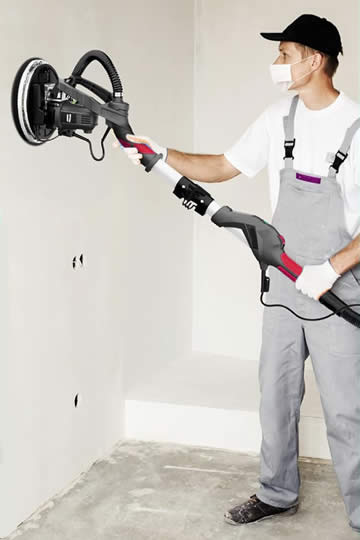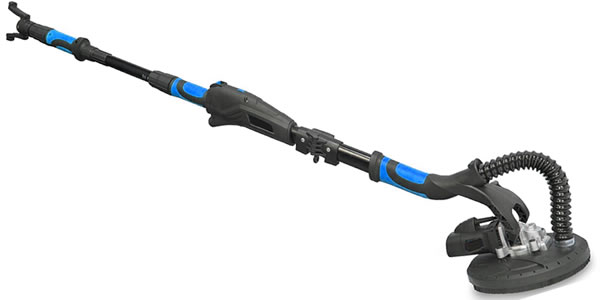Dustless Drywall Sander
A dustless drywall sander is a heavy duty tool that is indispensable when you need to smooth large areas of drywall in the shortest time possible while maintaining a clear, dust free and breathable atmosphere.
This page contains affiliate links. If you choose to purchase after clicking a link, I may receive a commission at no extra cost to you.
This means if you intend to start a big renovation project and part of that project involves drywall work, renewal or re-plastering, then you are going to need to provide a professional looking finish for painting over or wall papering once all the construction and renovation works are complete.
Now there are a couple of options that you can go with here depending upon your particular renovation project. The first is a standard or regular drywall sander and the second is a dustless drywall sander.
The first option is fine for smaller sanding jobs such as tackling small repairs or small areas of drywall that have been re-plastered following damage by water or accidental damage. These sanders are smaller and lighter but they will send up a lot of dust, so it is essential that you wear a good breathing mask to protect your lungs.
The second option is for larger areas of drywall or entire renovated or renewed drywalls where you need to put down a good, flat finish ready for priming and covering.
For this job you really should opt for a dust free drywall sanding machine as they are larger and can cover a larger area of drywall faster, while removing almost all of the dust before it gets into the air.
This is the major advantage of a dust free device over any other regular sanding machine.
There are a number of different makes and models on sale at Amazon right now and I have linked to a page that lists several great options. Click the image below:
Note: As an Amazon Associate I earn from qualifying purchases.
How Does a Dustless Drywall Sander Work?
This type of sanding device uses a venting system which is connected to a powerful vacuum that literally sucks all of the dust into its collection bag before it gets a chance to scatter into the atmosphere.
On good quality machines, the percentage of dust extracted in this way can approach 99 percent or better and leaves the air clear and breathable, although it is still recommended that operators wear a breathing mask as an added safety measure in case of accidents.
Advantages of a Dust Free Sander for Dry Walls
 One great advantage of a high quality, professional dustless sanding tool apart from its ability to prevent dust clouding up the air in a room is that it has the ability to allow the operator to get the job done in far less time than it would take them using a smaller machine.
One great advantage of a high quality, professional dustless sanding tool apart from its ability to prevent dust clouding up the air in a room is that it has the ability to allow the operator to get the job done in far less time than it would take them using a smaller machine.
Units such as the popular and highly regarded AYA-TECH Drywall Sander for example, can cover a large area fast thanks to its course and aggressive sanding action.
Another advantage of a professional drywall sanding vacuum system is that it will outlast lower quality models by a considerable amount, which actually makes them more economical in the long run as you only have to buy the one tool instead of having to constantly replace cheaper models as they wear out faster.
Of course, there is no getting away from the major advantage with this type of sander and that's its efficient removal of plaster dust from the air before the operator gets to breathe any of it into his lungs. This is a major health risk and so is vitally important that as little dust as possible is produced. A professional quality sander will achieve this exacting standard and mean cleaner air and minimised risk of breathing in dangerous dust.
Disadvantages of a Dustless Drywall Sander
There are one or two disadvantages of a professional quality machine. One of the main ones is that they are relatively heavy.
As a case in point, the AYA-TECH Sander actually weighs a hefty 12 pounds (or 5.4kg) and while this may not sound like all that much, once an operator has been holding one of these at shoulder level for anything more than just a few minutes, their arms will begin to feel the weight as muscle fatigue starts to set in.
The downside of this means an operator will need to take several breaks during operation, potentially lengthening the time the job will take, although this can still be considerably less than if they were using a cheaper, smaller sander.
Of course, there is also the disadvantage of the price of this type of professional high quality dry wall sander, which can run to around a couple hundred dollars. This could be something that is beyond the budget of an ordinary homeowner or handyman who may only have light use for the unit in any case.
However, a professional builder or construction company will make far better use of a larger and more expensive machine and this will offset the costs through length of usefulness and time saved on the job.
Another disadvantage more especially to the part time handyman or average homeowner is the running costs of a large, professional no-dust sander for drywalls. This includes the additional cost of the larger sanding sheets which will be more expensive than regular size sheets used by smaller domestic use sanders.
Why Would You Need One?
For the professional builder or renovation company, this cost will of course be reduced by their ability to buy these accessories in bulk and at trade cost which is discounted on domestic tool and accessory retail prices.
Another advantage of a professional sander for drywalls with a vacuum system is that it will outlast lower quality models by a considerable amount, which actually makes them more economical in the long run as you only have to buy the one tool instead of having to constantly replace cheaper tools and models as they wear out faster.
Ultimately, the choice is for you to decide whether you want a large, heavy but fast and professional grade free of dust drywall sanding machine that will get the job done in far less time or a smaller domestic unit that is cheaper to buy and run, but will produce much more dust and take longer to get the job done.
Posted: January 5, 2024
[BACK TO TOP]
